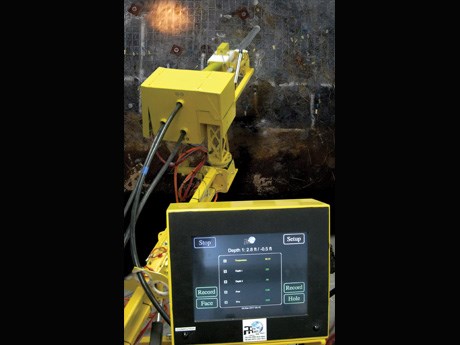TesMan, a Sudbury-based mining supplier, has sold two SP-TRL remote loaders to Vale’s Coleman Mine for cleaning and loading blastholes.
Development of the remote loader began in 2012 following the death of Vale miner Stephen Perry, 47, who was struck by a 14-tonne wedge of rock that dislodged from the face on the 4,215-foot level at Coleman Mine.
The remote loader attaches to the basket of an anfo or emulsion loader and keeps the operator 17 feet (5.18 metres) back from the face and out of the high-risk zone.
Rod Steele, co-owner of TesMan, likens the solution to a Swiss army knife with a set of tools that are fed into the hole from a distance. There’s an air hose to blow out the moisture and loose debris, a hammer tool to break up any obstructions, an endoscope to see into the hole, an auger to clean out the lifters and kneeholes, a tamping tool for loading stick powder and a screen cutter to cut screen obstructing the hole.
The Coleman joint health and safety committee and mine management worked closely with TesMan to design the solution.
Aside from keeping miners away from the face and out of danger, the SP-TRL allows for improved breakage, claims Steele.
The operator can see the depth of each hole on the screen, so if he has a short-drilled hole, he can sequence it to blast at the same time as another neighbouring full-length hole for optimum breakage.
If an operator doesn’t know the depth of the holes and fails to make the necessary adjustments to the timing, the quality of the blast and the advance rate of the round are compromised.
Based on some 10 to 15 rounds performed at NORCAT’s Underground Centre north of Sudbury, Steele estimates the remote loader can potentially improve advance rates by five to 10 per cent.
Quality blasting will result in less damage to the walls, less rework and more efficient bolting.
The remote loader captures video from the endoscope and a face camera, along with all the data and comments pertaining to the cleaning, loading and conditions encountered for end of shift reporting to the engineering group.
Looking to the future, “the other opportunity is automation,” said Steele. “There’s only one aspect of tunneling that hasn’t been mechanized, and that’s cleaning and loading, so now that we’ve mechanized the operation, we can look at performing it remotely from surface,” said Steele.
Other options for the future include mounting the arm and tools on a specially designed platform with a portable loading unit for smaller headings, and attaching the remote loader to a boom without a basket, which would position the operator “midship” – 40 feet away from the face.
A commercial version of the remote loader was put through its paces by Vale operators at the NORCAT Underground Centre in October and was scheduled to be relocated to Coleman the following month for additional training.
“Glencore is also paying attention to the project,” said Steele. “They are going to come out and have a look and we are talking to a few other mining companies. Our strategy is to focus our sales efforts locally at first and then move further afield.”
Sudbury based Industrial Fabrication, manufacturer of the Minecat line of underground utility vehicles, is handling sales for TesMan.
Development of the remote loader was assisted by the Northern Ontario Heritage Fund Corporation and the National Research Council of Canada’s Industrial Research Assistance Program.
“Vale and Coleman Mine have been extraordinary in extending assistance to us,” said Steele. “They freed up operators to spend time with us on the development of the remote loader, allowing us to design it with their input.”
Use of the NORCAT Underground Centre, the former Fecunis Mine, was also of critical importance.
“If you have a new technology that is not tested underground, you’re relying on your clients to do it, and that impacts on production, so it’s ideal to have a site like NORCAT.”
KGHM International also assisted by loaning TesMan an anfo loader and jumbo for the testing.



